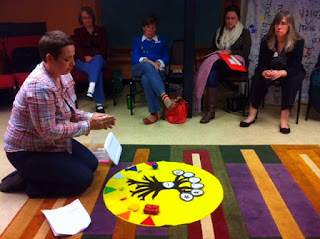.JPG) |
| Kris has been a UU religious education teacher for 12 years. She's tried several different UU curricula, and was learning Spirit Play for the first time. The story she told us was "The Flaming Chalice," and is among the first lessons in the Spirit Play classroom. |
Thoughts and ideas on the Unitarian Universalist Spirit Play method of religious education, which is grounded in Montessori methods and inspired by the Episcopal Godly Play.
Saturday, May 4, 2013
Training Day
Labels:
training
Subscribe to:
Post Comments (Atom)


.JPG)
.JPG)

That final story is titled "Sources" but we call it "Tree." It can be told in stages, across two or three weeks. This allows more detailed "wondering." We use it twice every year, in September and May, so the kids (and storyteller) know it well. (You can deemphasize parts of it, shortening the time it takes.) I liked using it in our parent orientation, too, because there's this "ah-ha!" among so many of the grown ups when they "see" those abstract words "mapped" this way. :-)
ReplyDeleteMichelle, I love that idea, emphasizing or de-emphasizing certain elements in retellings of the story within the same RE year. And how cool that the adults get so much out of it, too! There is really something wonderful about the kinesthetic and visual/spacial presentation that pulls people in in a way other methods don't...
ReplyDelete